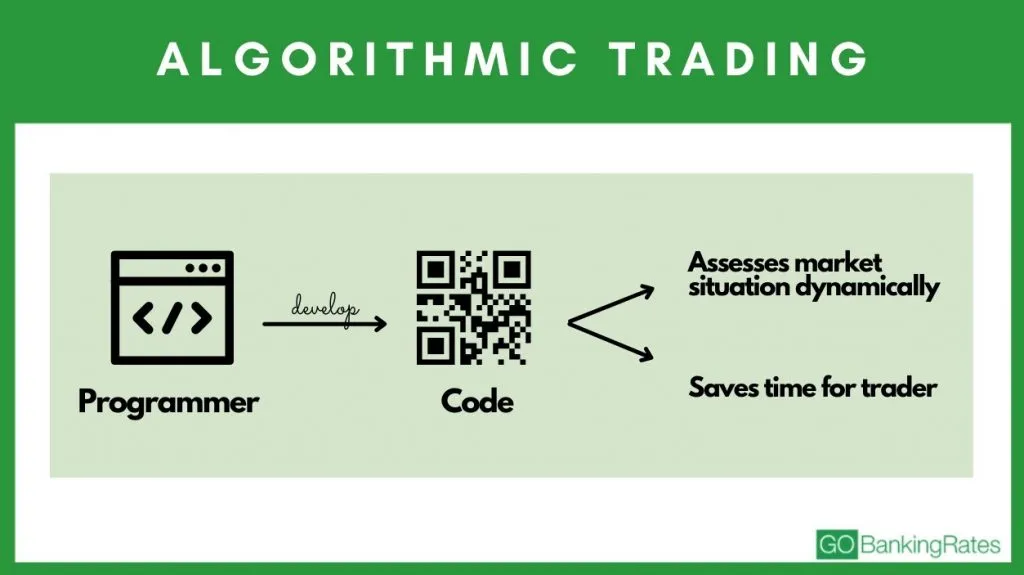Algorithmic Trading: What It Is and What It Does for Investors

Commitment to Our Readers
GOBankingRates' editorial team is committed to bringing you unbiased reviews and information. We use data-driven methodologies to evaluate financial products and services - our reviews and ratings are not influenced by advertisers. You can read more about our editorial guidelines and our products and services review methodology.

20 Years
Helping You Live Richer

Reviewed
by Experts

Trusted by
Millions of Readers
These days, many aspects of our lives are being overtaken by an algorithm — from our online searches to our social media accounts and even our investments. You may hear terms thrown around — for example, algorithmic trading, automated trading, algo-trading or black-box trading. These terms all refer to the same thing, but what exactly is it?
What Is Algorithmic Trading?
Algorithmic trading is the purchase or sale of stocks and other types of investment assets via automated electronic order. In other words, software can be programmed with instructions to buy or sell an asset. The same way that your social media news feed is programmed to show you more of the content that you already like to consume, your investment account can be programmed to acquire or purge assets depending on the specified instructions — when a certain price or rolling average is reached, for example.
How Algorithmic Trading Works
What type of trade could you perform via algorithm? A common example would be to buy a large number of shares of your target investment when its price, or even its moving average over a specified period of time, reaches a certain target. Those instructions, issued via software, will ensure that the investment gets monitored and that no trading activity happens unless the circumstances of that asset match your selected buy or sell instructions.
How Common Is Algorithmic Trading?
According to one estimate, algorithmic trading is responsible for 60% or more of all equity trades executed in the U.S. The same report seems to indicate that it’s on the rise, up at least 10% from the start of the COVID-19 pandemic.

When Is Algorithmic Trading Most Useful?
In most instances, algorithmic trading is helpful for buying investment assets in bulk. In the same way that Costco sells groceries and home essentials in bulk to offer those items to consumers at a reduced cost, algorithmic trading moves investment assets in bulk as a way to offer customers low-cost portfolios that adjust continually.
Is This What Robo Advisors Do?
Yes and no. Much like algorithmic trading, robo-advisors run on automation. With a robo-advisor, you specify the amount of time you plan or hope to spend in the market before needing the funds and choose the risk level you’re most comfortable with. From there, the software takes over, running your portfolio in an automated way. The fees associated with this type of account tend to be very reasonable since there’s no financial advisor acting as the go-between.
Once you’re off and running with a robo-advisor, you can be fairly hands-off and shouldn’t have to get involved in rebalancing your portfolio. With algorithmic trading, however, there’s a greater amount of flexibility when it comes to the kinds of assets you invest in — so you may want to have periodic check-ins to evaluate whether or not your strategy is working for you. If you keep an eye on things, you can then make adjustments as needed. Algo-investing comes with the opportunity and responsibility of exerting more control over the automated parts of your portfolio.
Is Algorithmic Trading the Same Thing as High-Frequency Trading?
They are related to each other. High-frequency trading is a form of algorithmic trading. It’s used primarily by hedge funds and other commercial investors. Due to the complex nature of high-speed trading and the technology involved, it is not a widely accessible opportunity. Other forms of algorithmic trading, though, are available to everyone.
Top Reasons of Algorithmic Trading
There are many good reasons for using an algorithm to drive trades, including but not limited to identifying trends to take advantage of market movement patterns, scooping up investment assets at a lower price on one market and selling them at a higher price on another. Algorithm-based trading can also be useful for identifying trading opportunities based on asset price ranges, percent change, average value, volume and shortfall.
Drawbacks of Algorithmic Trading
Although investing by algorithm is generally a way to save money by eliminating advisor fees, there can be risks to letting machines run the show. By operating at a high frequency, algorithmic trading allows professional traders and hedge funds to seize arbitrage opportunities. This means that when the algorithm spots an investment asset at a particularly low price, the algorithm can buy it and then sell it at a higher price on a different market.
Since retail, or everyday, investors may not be able to act as quickly as professional money managers, they’re at constant risk of being outperformed by people with better access to trading resources. An analysis by the Financial Conduct Authority, a U.K. regulator, asserts that these high-frequency hedge fund practices lead to a lower trading volume on the market overall and cost up to $5 billion yearly in global exchanges.
Good to Know
Most algorithmic trading happens on the platform called Meta Trader 4, or MT4. If you’d like to try algo-trading before deciding if it’s right for you, you can open a demo account risk-free.
Algorithmic Investing: A Mixed Blessing
In some ways, investing has never been easier. Technology has disrupted the finance industry, and tools like algorithmic investing have made it easier to rebalance funds and act quickly — literally in the blink of an eye — on desirable investment opportunities. It has removed any logistical turmoil or cost associated with financial advisors and brought newfound abilities to everyday investors, including the opportunity to demo algorithmic investing without risk.
At the same time, algorithmic investing has made speed the name of the game. If the market is moving in a positive direction, then everyone stands to benefit — and quickly! If the market is experiencing a meltdown or mishap, however, the nature of algorithmic trading guarantees a response — which might be devastating. Given the increasing prevalence of algorithmic investing, only one thing is guaranteed — just like with our news feeds and social media accounts, automated finance is here to stay.
Our in-house research team and on-site financial experts work together to create content that’s accurate, impartial, and up to date. We fact-check every single statistic, quote and fact using trusted primary resources to make sure the information we provide is correct. You can learn more about GOBankingRates’ processes and standards in our editorial policy.
- Mordor Intelligence. "Algorithmic Trading Market | 2021 - 26 | Industry Share, Size, Growth."
- Velvetech. 2021. "The Role of High-Frequency and Algorithmic Trading."
- Financial Conduct Authority. 2020. "Occasional Paper 50 - Financial Conduct Authority."
- CNBC. 2020. "Latency Arbitrage Trading Costs Investors $5 Billion a Year: Study."
- MoneySmart. 2019. "Algorithmic Trading vs Robo Advisors - What is the Difference?"
 Written by
Written by  Edited by
Edited by 
























